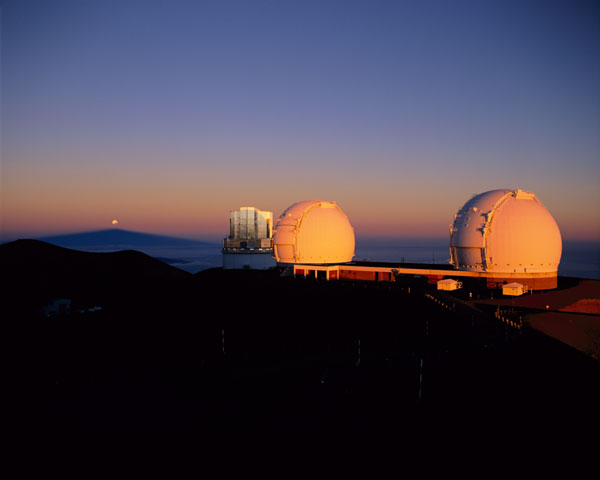Mauna Kea (January 13th, 2006) A team of scientists in partnership with the W. M. Keck Observatory in Hawaii have successfully passed the first test in a project that will link the seven largest telescopes on Mauna Kea together to create a gigantic imaging instrument nearly one half mile (800 meters) in diameter. The ‘OHANA (Optical Hawaiian Array for Nanoradian Astronomy) array, or “interferometer,” will provide ultra-high resolution images of the near-infrared universe, 80 times more accurate than a single 10-meter Keck telescope. The results of the first successful test between the two Keck telescopes are described in the January 13th issue of Science.
An interferometer is a type of instrument that combines light from two or more telescopes to obtain measurements with higher resolution than what could be obtained with a single telescope alone. With conventional telescopes, the size of a single, primary mirror will determine its ability to resolve small-scale structure on the sky. But with an interferometer, the distance between the telescopes, or “baseline,” will determine the angular resolution.
“The next large telescopes will certainly be 30 to 50 meters in diameter, when some of the answers we are looking for would require mile-long diameters. Only interferometers can achieve this; and the Mauna Kea summit is the only place where we can find large optical telescopes spread over such distances,” said Dr. Fred Chaffee, director of the W. M. Keck Observatory.
The `OHANA project, named after the Hawaiian word for family and extended family, will eventually link the Subaru Telescope, NASA Infrared Telescope, Gemini Observatory, Canada-France-Hawaii Telescope, the United Kingdom Infrared Telescope Facility and the Keck I and Keck II telescopes together with “single-mode” optical fibers never used before to transport the light between telescopes.
“The use of fibers to transport the light between telescopes is one of the main challenges of the `OHANA project,” said Dr. Olivier Lai, resident astronomer at the Canada-France-Hawaii Telescope.
When complete, ‘OHANA will be the most highest-resolution, near-infrared instrument in the world—capable of producing images with an unprecedented resolution of 0.5 milliarcseconds, about the size of an edge of paper as seen from one hundred miles away. It will be used to take detailed images of stellar surfaces, giant gas planets, long-period variable stars and significantly advance the understanding of stellar astrophysics.
Modern interferometers typically have baselines a few hundred yards in distance. Increasing the distance (and its corresponding resolving power) usually requires a large number of mirrors, each of which deteriorates the quality of light arriving at the detector for measurement. A solution to this problem may be single-mode optical fibers which transmit light only at a particular wavelength of interest and significantly reduce the loss of light over large distances. The first experiment of the `OHANA project was to test the effectiveness of these types of fibers and to determine the feasibility of using them with long baseline optical interferometers.
The first `OHANA test was conducted on June 17 with the Keck I and Keck II telescopes. Both telescopes guided on a relatively bright star (107 Hercules), located 278 light years away. The single-mode fibers were used to transmit the infrared light over a simulated baseline of ~550 yards (~500 meters), which was then coherently combined and successfully measured. The experiment was the first major milestone for the future of very large optical arrays connected with optical fibers.
“This first success is not only important for `OHANA but also a major milestone towards future kilometric arrays of telescopes in the near infrared,” said Dr. Guy Perrin, astronomer at Paris Observatory.
Future tests will link the Canada-France-Hawaii Telescope with the Gemini North telescope, followed by other baselines such as Subaru Telescope to W. M. Keck Observatory for example. The goal of each test is to characterize the baseline between telescopes before completing the entire Mauna Kea array.
A unique aspect of the `OHANA project is its non-invasive approach for expanding the capabilities of the existing facilities at Mauna Kea. In response to community concerns, many scientists at Mauna Kea are seeking ways to efficiently use the existing world-class telescopes in creative new ways. The `OHANA project will not require the construction of any new permanent facilities, and the very thin optical fibers used to connect the telescopes can be installed using the existing roads and infrastructure of the Astronomy Precinct.
“OHANA demonstrates the spirit of cooperation between the observatories on Mauna Kea to make the best use of the existing research resources whenever possible,” said Dr. Rolf Kudritzski, director for the Institute for Astronomy at the University of Hawaii, which manages the astronomy research program at Mauna Kea. “The ‘OHANA Project uses the best of what we have to combine the power of the largest telescopes in the world to create a unique new astronomical facility of unprecedented capability. This is a milestone for the future of astronomy on Mauna Kea.”
The ‘OHANA project is led by Paris Observatory in collaboration among Canada-France-Hawaii Telescope Corporation, W.M. Keck Observatory, the National Astronomical Observatory of Japan, Gemini Observatory, United Kingdom Infrared Telescope, NASA Infrared Telescope Facility, the Institute for Astronomy at the University of Hawaii, the National Optical Astronomical Observatory, the, Institut National de Rercherche en Communication Optique et Micro-Ondes and Institut National des Sciences de l’Univers du CNRS.
The W. M. Keck Observatory is operated by the California Association for Research in Astronomy (CARA), a non-profit 501 (c) (3) corporation whose board of directors includes representatives from the California Institute of Technology, the University of California, and the National Aeronautics and Space Administration.


